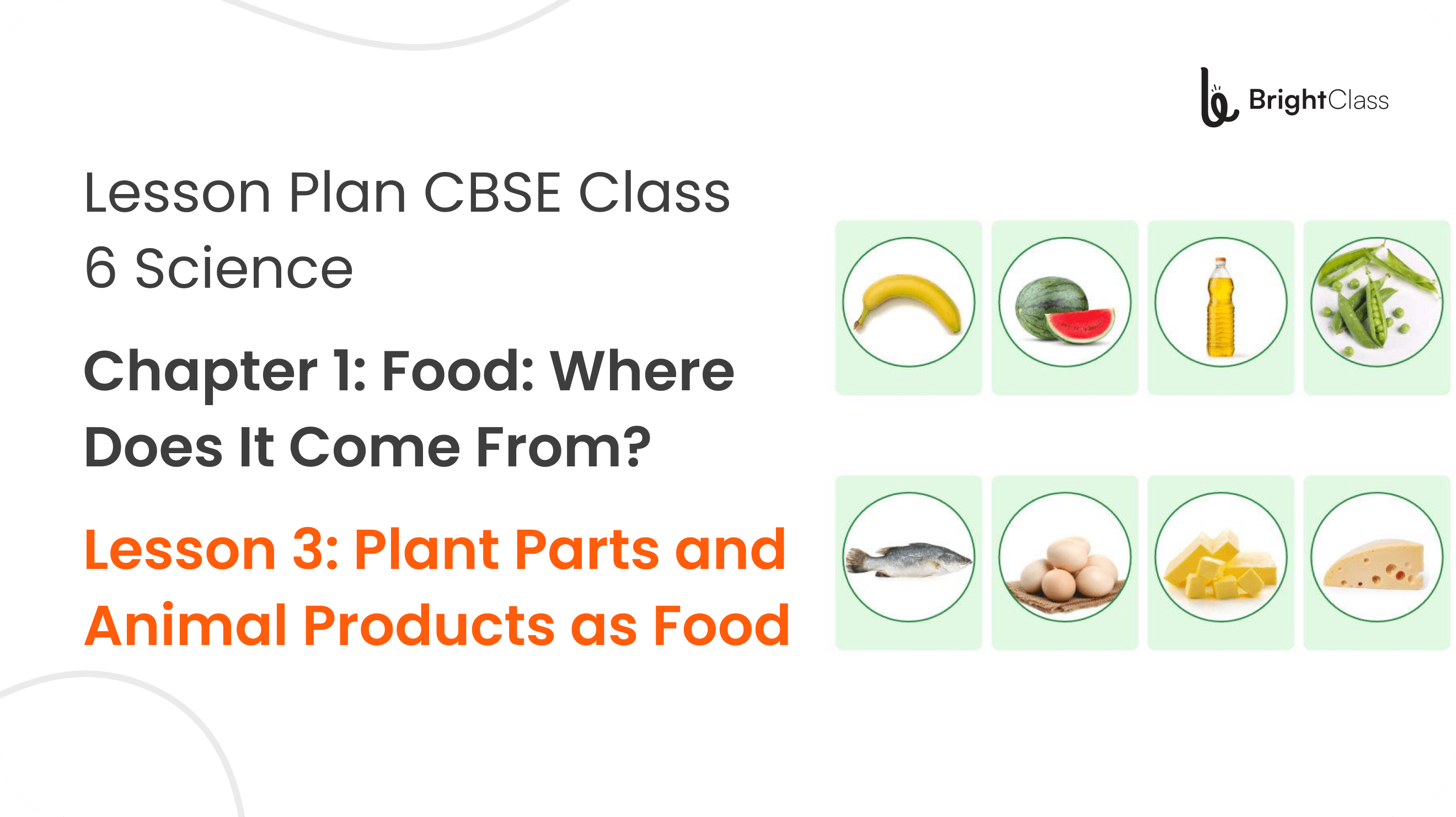
Lesson Plan for CBSE Class 6 Chapter 1: Food: Where Does It Come From? Lesson 3: Plant Parts and Animal Products as Food
The chapter "Food: Where Does It Come From?" in Class 6 Science is important for students. Students can grasp the origins of their food, comprehend the intricacies of plant and animal products, and appreciate the dynamics of a food chain.
A thoughtfully crafted lesson plan incorporates engaging activities and practical examples, making the learning experience enjoyable and memorable for students. It caters to diverse learning styles, encourages active participation, and stimulates curiosity, fostering a genuine interest in the subject.
A well-organized lesson plan aids students in setting clear expectations, understanding learning objectives, and tracking their progress. It creates a cohesive learning environment that promotes retention and application of knowledge, empowering students to connect theoretical concepts with real-world scenarios. In essence, a comprehensive lesson plan enhances the overall educational experience for students, making the study of "Food: Where Does It Come From?" not just informative but also exciting and relevant to their daily lives.
Lessons in Chapter 1: Food: Where Does It Come From?
- Food variety
- Food materials and sources
- Plant parts and animal products as food
- What do animals eat?
Here is the Lesson Plan for Plant Parts and Animal Products as Food under the chapter Food: Where Does It Come From?
This lesson plan is according to popular 5E’s Framework using the BrightClass application. Try it now for free.
Implementing the 5E instructional framework - Engage, Explore,
Explain, Elaborate, and Evaluate - enhances the effectiveness of a
lesson plan for the "Food: Where Does It Come From?" chapter in Class
6 Science. By engaging students with compelling introductions,
encouraging exploration of concepts through hands-on activities,
providing clear explanations, fostering elaborate discussions, and
assessing understanding, the 5E model creates a dynamic and immersive
learning experience. This systematic approach ensures that students
actively participate, comprehend, and retain information, transforming
the lesson into a journey of discovery. The 5E framework tailors
education to diverse learning styles, making the study of food origins
not just educational but engaging and memorable.
Engage
OBJECTIVES:
- To activate prior knowledge about plant parts and animal products as food.
HOOK:
Show the students pictures of different types of food including fruits, vegetables, grains, meat, and dairy products. Ask them to identify the plant or animal part that each food item comes from.
PREVIEW:
Today we will be learning about the different components of plant parts and animal products that we consume as food.
Explore
OBJECTIVES:
- To observe and identify different plant parts and animal products.
MATERIALS:
Various fresh fruits and vegetables, grains, meat, dairy products.
PROCEDURE:
- Divide the students into small groups.
- Distribute different types of food items to each group.
- Ask the groups to observe the food items and identify the plant or animal part that each food item comes from.
- Encourage discussions within the groups to share their observations and findings.
- Take feedback from each group and discuss the correct answers as a class.
- Summarize the observations and introduce the concept of plant parts and animal products as food.
CLOSURE:
Ask the students to share one interesting fact they learned about plant parts and animal products as food.
Explain
OBJECTIVES:
- To describe the different components of plant parts and animal products as food.
MATERIALS:
Visual aids (diagrams or pictures of plant parts and animal products)
PROCEDURE:
- Use visual aids to show diagrams or pictures representing different plant parts and animal products.
- Explain the function and importance of each component in the food.
- Provide examples and explanations for each component, such as fruits being a source of vitamins and minerals, grains being a source of carbohydrates, meat being a source of protein, etc.
- Encourage questions and discussions to ensure understanding.
CLOSURE:
Recap the different components of plant parts and animal products as food, emphasizing their importance and role in a balanced diet.
Elaborate
OBJECTIVES:
- To describe the different components of plant parts and animal products as food.
MATERIALS:
Visual aids (diagrams or pictures of plant parts and animal products)
PROCEDURE:
- Use visual aids to show diagrams or pictures representing different plant parts and animal products.
- Explain the function and importance of each component in the food.
- Provide examples and explanations for each component, such as fruits being a source of vitamins and minerals, grains being a source of carbohydrates, meat being a source of protein, etc.
- Encourage questions and discussions to ensure understanding.
CLOSURE:
Recap the different components of plant parts and animal products as food, emphasizing their importance and role in a balanced diet.
Elaborate
OBJECTIVES:
- To reinforce understanding of the different components of plant parts and animal products as food.
MATERIALS:
Worksheets or handouts with questions related to plant parts and animal products.
PROCEDURE:
- Distribute worksheets or handouts to the students.
- Instruct them to answer the questions based on their understanding of plant parts and animal products as food.
- Allow them to work individually or in pairs.
- Walk around the class to provide guidance and support.
- After completion
CLOSURE:
Summarize the key points discussed in the activity and address any remaining questions or concerns.
Evaluate
OBJECTIVES_ACHIEVED:
- Students will be able to identify and describe the different components of plant parts and animal products as food.
HOMEWORK_ASSIGNMENT:
Ask the students to create a poster or infographic illustrating the different components of plant parts and animal products as food, along with their functions and importance.
ADDITIONAL_COMMENTS:
Encourage creativity and neatness in the homework assignment. Provide feedback and reinforcement of the key concepts in the next class.

